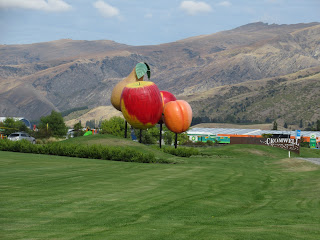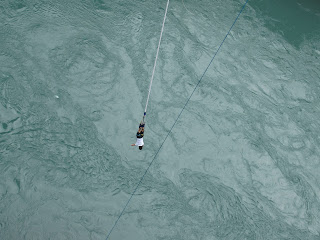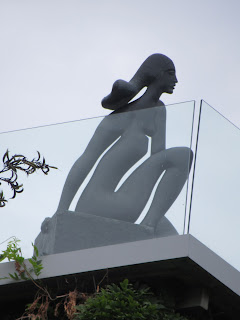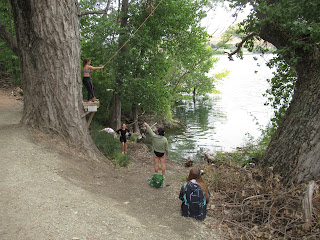I am simultaneously finishing a travel blog about the 4.5 month long trip Steven and I took last fall to Armenia, Georgia, Azerbaijan, much of Central Asia, and then the final six weeks in Spain and Portugal. If you're interested in checking that exciting adventure out, here's the link: www.bergersadventures6.blogspot.com
After spending two nights in Twizel and hiking for the day in the fabulous Aoraki/Mt. Cook National Park, Diane and I drove along the South Island's Southern Heritage Route toward Queenstown, the country's adventure capital. Part of the road down the center of the island was through a 'mountain pass' although by our native Colorado standards, it was pretty wimpy! The view of the gently rolling hills was, however, very attractive.
Diane: I don't think either of us will soon forget this image as we kept seeing them representing the fruit orchards around the town of Cromwell in our effort to get on the right road to Queenstown, will we?! We began seeing fruit stalls up and down the road but blueberries were selling for NZD$10 a kilo which was enough to scare me off then. If I had converted that amount right then and there, it would 'only' have been about $3.25 a pound so not so bad after all.
While views were important, the wildings also destroyed a region's ecology as the native shrub and tussock grassland were host to a range of herbs and grasses that in turn provide habitat for many insects, lizards and birds. In addition to invading farms and therefore ruin productive lands, a wilding forest also pose a serious risk of wildfires.
The wildings were painstakingly eradicated using a combination of spraying, logging and hand cutting of saplings. The sprayed trees will rot and decompose into the soil. Although unsightly at first, over time the native shrubs and tussocks will return to the mountainous countryside.
The etching on the sculpture encouraged "Awake, my little ones and fill the cup before life's liquor in its cup run dry." Good advice, I say.
A sign described Lake Hayes as one of NZ's most beautiful lakes and that everything possible needed to be done to protect and enhance its water and ecosystem. The lake was a haven for wildlife, both above and below its water surface. It was popular for fishing for brown trout and perch and home to several varieties of native fish species.
After spending two nights in Twizel and hiking for the day in the fabulous Aoraki/Mt. Cook National Park, Diane and I drove along the South Island's Southern Heritage Route toward Queenstown, the country's adventure capital. Part of the road down the center of the island was through a 'mountain pass' although by our native Colorado standards, it was pretty wimpy! The view of the gently rolling hills was, however, very attractive.
We stopped at the Lindis Pass lookout for a brief hike to its summit.
The monument commemorated the centenary of the first liberation of red deer in the large Otago region in March of 1871 who had been shipped by the 11th Earl of Scotland and then transported over the pass by bullock wagon.
From the summit we had wonderful views of the valley. The mountains in the second photo reminded me of the much bigger Flatirons on the way to Boulder from Denver.
While driving through Central Otago, we'd seen a low lying plant that was new to us called snow tussock. It grew from sea level to high altitudes and had the ability to catch and hold water like a sponge. The region's spectacular shrub and tussock-covered mountains was one of New Zealand's iconic landscapes.
Diane: I don't think either of us will soon forget this image as we kept seeing them representing the fruit orchards around the town of Cromwell in our effort to get on the right road to Queenstown, will we?! We began seeing fruit stalls up and down the road but blueberries were selling for NZD$10 a kilo which was enough to scare me off then. If I had converted that amount right then and there, it would 'only' have been about $3.25 a pound so not so bad after all.
East of Queenstown, we began seeing winery after winery.
As we drove along the beautiful Kawarau Gorge, it was so much fun seeing signs for gold panning!
This was the first time we'd seen such a huge number of dead trees anywhere in New Zealand. We didn't have to wait long before finding out what had killed them as there was a big display about them at the next lookout. Kawarau Gorge was a dead forest and a stark contrast to the usually magnificent high country. What we'd seen in the gorge was the demise of unwelcome 'wildings' or weed trees that had been smothering the unique vistas. A sign promised that if we were to return 'in the future,' we would see that the shrub and tussock landscape had returned. I wondered how long was meant by 'the future.'
Wildings were exotic trees that were fast growing and prolific producers of seed. They were first planted with good intentions to shelter homes, protect livestock, prevent erosion and establish forests. Unfortunately however, the wildings quickly spread over slopes that were treeless as little as just twenty years ago. If they were left uncontrolled, wilding forests would engulf all the surrounding hills.
The wildings were painstakingly eradicated using a combination of spraying, logging and hand cutting of saplings. The sprayed trees will rot and decompose into the soil. Although unsightly at first, over time the native shrubs and tussocks will return to the mountainous countryside.
The Roaring Meg was a turbulent stream that merged with the Kawarau River according to a sign at the lookout. I wasn't quite sure what constituted Roaring Meg, i.e. the stream, versus the river as the 'stream' looked far more like a raging river to me through the gorge. The unusual name may have come about from Maggie Brennan, a "voluble, red-haired barmaid from the nearby Kyrtleburn Hotel." I liked the following version much more, though! It involved an early party of diggers who were accompanying two ladies from a dancing saloon. At the first stream the group came to, the gentlemanly diggers carried the ladies across. One of them made so much fuss, they named the stream after her: Roaring Meg. In contrast, the other woman was perfectly calm and silent so the diggers named the next stream they came to that was smaller and quieter as Gentle Annie!
As we drove west toward Queenstown, again we kept seeing winery after winery, many of which had vines covered by a gauze-looking material that we'd never seen in any other wine producing area in the world.
We'd planned for several days to stop at Chard Farm, a vineyard perched on a rare flat spot on the edge of Kawarau Gorge. The winery had the most hair-raising drive to it with constant hairpin turns and steep plunges over cliffs if Diane wasn't such a careful driver. Signs along the road kept reminding drivers of the precipitous cliffs and no jumping off them was allowed! I couldn't begin to imagine driving or being driven along this road if I or the driver had imbibed a lot at the winery.
At the winery's 'cellar door' or tasting room, free samples were offered up to six choices - luckily Diane didn't have all six!
You'll get a smile out of reading the Tasting Room rules!
We were both rather disappointed by what turned out to be our only winery visit even though the wine was free. Visitors were asked to donate money instead to an area hospice. Unfortunately, there was no winery tour or information provided abut the winery's origins.
There were fun bathroom signs to add to my 'collection,' though!
I wonder when the photo of the winery's namesake Fred Chard on a horse mower had been taken.
Though our visit to the winery was a bit of a bust, we managed to find a spot to eat the sandwiches we'd prepared amid lovely surroundings before driving back on the rather treacherous mostly one-lane road.
We stopped off next across the highway at the world's first Bungy jump as it sounded way too exciting to pass up.
I am pretty darn sure I will never ever see a bathroom sign like this one anywhere again!
I couldn't resist taking a picture of the sign in the stall as it reminded people that it was "customary in NZ to put used toilet paper into the toilet and flush toilet after use." Click on the picture to read the rest of it more easily for your smile of the day!
Neither Diane nor I were quite gutsy enough to try bungy jumping; the next best thing was to watch someone else do it. Steven: It reminded me of those brave people we saw in '16 at Victoria Falls jumping off the bridge dividing Zimbabwe and Zambia. Remember that?
The Kawarau Suspension Bridge was opened in 1881 and provided a permanent means of crossing the Kawarau River, replacing the punt at nearby Morven Ferry. The bridge was needed to improve access to and from the goldfield but what proved to be difficult was designing a bridge over a sheer rocky gorge 42 meters deep that funneled destructive winds. English engineer Harry Higginson's award-winning design was innovative, economical and enduring. The bridge became the world's first commercial Bungy jumping site in 1988 - a leap now made by thousands of people each year.
I read that the origins of the Bungy phenomenon lay in Pentecost Island, Vanuatu, where, for centuries, the people fearlessly 'land-dived' from high towers made from trees with only a few vines tied to their feet. Originally only women jumped as part of an annual fertility ritual based around the yam harvest. Christian missionaries, offended by upended naked women however, demanded the jumping be restricted to men - a test of courage that continues to now.
Inspired by this tradition, the Oxford University Dangerous Sports Club tried a few experimental jumps in the 1970s which inspired A.J. Hackett and a fellow Kiwi to develop and test their own bungy cords. They used them to jump off every bridge they could find in New Zealand and France; from the startled reactions, they realized they were onto something special. In 1987, Hackett sneaked up the Eiffel Tower at night and hurled himself from the iconic structure first thing in the morning. He was immediately arrested, but was released almost as quickly. The jump made global headlines and the bungy phenomenon began. When Hackett opened the world's first commercial bungy operation here at the Kawarau Bridge in 1988, 28 people paid NZD$75 each to test their courage.
Just five minutes later, we began a lovely hike/stroll along the Lake Hayes Trail described as probably the best walk in the Wakatipu Basin on a hot summer's day. Thought it was early fall, the idea of getting some exercise and not being cooped up in the car sounded absolutely delightful. The lake was also well known for its brilliant reflections and once supplied most of the fish in the district.
Diane and I were both intrigued by all the different shades of red berries we'd seen while in New Zealand. The bushes along the lake had plenty more to look at and admire.
No doubt, some small animals or rodents used these holes along the path as their homes. We just hoped they stayed inside!
These looked like buttercups but I was by no means sure.
I love how when we kept meandering along the path, we kept getting different views of the lake and the mountains that surrounded it. The reflections were indeed as pretty as described in the brochure I had found online several months earlier.
We figured these were animal traps but didn't know why they were placed around the lake nor what animal was being trapped and why.
There were several spectacular modern homes bordering the lake.
Some of the homes had easy boat access.
A little further on it looked we came upon a boat graveyard as each one had seen its glory days eons ago!
Diane and I both commented we sure wouldn't mind staying in this lovely stone home. As it turned out we could have for a price as it was a short term rental property!
I lamented the fact that some homeowner had transformed this stretch of native and natural looking shoreline into this mini lawn with palm trees. It looked so out of place with what was before and after it on the trail.
On our way back to the car, we noticed this group of girls/young women by a swim hole. The girl on the 'zip line' needed lots and lots of encouragement from her friends on the ground before she eventually got up the courage to fly through the air! I gave her lots of credit for not wimping out as I likely would have.
Near 6 pm, we finally reached Queenstown, the most popular tourist stop on the South Island. Once prized by the Maori as a source of greenstone, the town boomed when gold was discovered in the Shotover River (a place we explored the next day) during the 1860s. The river quickly became famous as "the richest river in the world." By the 1950s, Queenstown had become the center of a substantial farming area, and with ready access to mountains, lakes and rivers, the town has now become the adventure capital of New Zealand. Nowadays New Zealanders' penchant for bizarre adventure sports culminates in Queenstown, a city where tourists can sign up for anything from white-water rafting and jet-boating to heli-skiing, parachuting and paragliding, in addition, of course, to bungy jumping!
Since arriving in New Zealand a week ago, I had been hankering to eat lamb as the country is so well known for its mouth-watering lamb exports. All I could find at any of the restaurants so far was lamb shoulder so that was what I ordered here. It was more like a lamb stew and wasn't helped much by the lukewarm vegetables served with it. It was not a patch on the yummy lamb chops I sometimes treat Steven and myself to at our local Costco.
After dinner we wandered down the pedestrian Queenstown Mall or street toward the lakefront.
The statue by the water honored William Gilbert Rees (1827-1898), an explorer and the first European settler who founded Queenstown with his wife near this point in 1861. He then constructed the first buildings by the lake.
The town seemed to have very much a young person's vibe with bars and cafes every meter or so but there were pretty vistas along the lake with The Remarkables mountain range in the background.
I couldn't help but smile when I saw this giant kiwi bird sculpture!
Like every other town we'd seen so far in New Zealand, Queenstown also had its own war memorial which honored the heavy human losses suffered in WWI. Fundraising for Queenstown's Fallen Soldiers Memorial to remember the area's servicemen began in early 1920. The archway was placed at the entrance to the city's gardens and by the waterfront, considered to be a prominent location, to remind both locals and tourists of the sacrifices made by the Queenstown community.
The memorial was unusual as, on one side were the names of those who died while in service. The other side listed the names of all those who served, something I'd never seen before. Those men's names were included even though many returned service people objected as 'we have all received our welcome homes, these boys have not.'
One thing I shall always remember about our time in New Zealand is the abundance of weeping willow trees, something I always associate with the glorious willow tree in the front yard of the house across the street from my parents' home in Ottawa.
Next post: A hugely fun 4WD adventure into Skippers Canyon along the Shotover River!
Posted on March 28th, 2019, from our home in Littleton, Colorado.































































































"voluble, red-haired barmaid from the nearby Kyrtleburn Hotel." Its not me. Janina
ReplyDeleteGuess not, Janina!
DeleteThe bungee jumping did bring back memories of Victoria Falls. Not quite as crowded though!
ReplyDeleteRemind me to have you download and show how to use the currency converter app before you head to the place that shall not be named
ReplyDeleteThe war memorial was interesting and weird as I have never seen another war memorial list those who served in addition to those who died.
ReplyDeletewould be a great idea - thanks!
DeleteZachary, I hadn't heard of that either before. That's why I wanted to include it in the post to give people a sense of how others honor those who served.
ReplyDelete